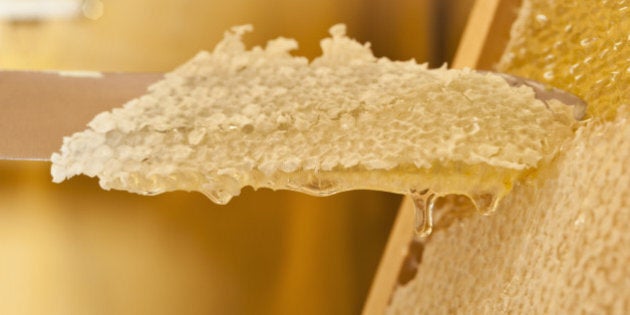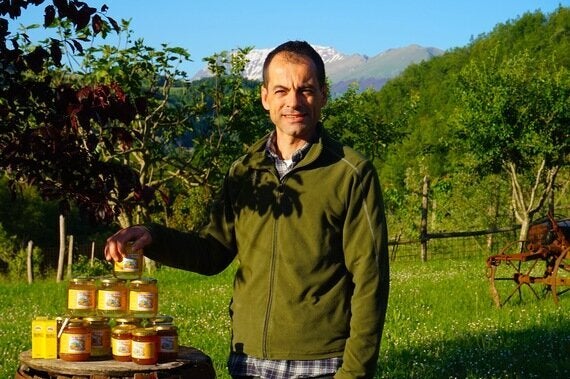
Think of Italy and one thinks of food, but not many people think 'mountains.' Yet mountains remain a principle source of the traditional, handcrafted food production Italy is famous for.
Since climate and gradients combined render large-scale industrial agriculture unfeasible, food traditions and environmental health endure in most of Italy's mountains. Partly because mountains don't feature highly in public awareness, Italy is experiencing increasing polarity and disparity in food production structures.
Small producers face complex issues due to climate change and politics.Three-time national award winning honey producer in the Sibillini Mountains Italy, Sergio Corridoni explained it thus:
"Overall we only have two types of general food production. The big industrial producers who control the market and who produce a set quota, regardless of changes in the climate or the health of the animals. They do whatever they have to, to produce. They use GM products, import low priced products to boost their productivity and use all the pesticides and herbicides on the market. On the other side, there are the small producers who control their entire production chain. I have to sell everything I produce myself with my own hands. Otherwise I lose too much money and the quality of my product would be compromised. We are largely forgotten."
In Sergio's case his talent has made his business. Yet he walks his mountain path alone, in more ways than one.
Repeatedly winning at Grandi Mieli D'Italia, Una Goccia d'oro, an award for the best honey produced in Italy, most recently in 2015, has been useful for word of mouth. He sells everything the bees produce faster than he can make it. A few people all over Europe place their orders for his honey, often a season in advance.
"When I run out, I stop selling. Others import low priced honey from Argentina, which arrives in Ancona. Then they put their label on it and sell it as mountain honey because their business is based here. No one controls what is actually produced in the mountains and what isn't," he explains.
He takes his product to mountain food fairs but Sergio avoids shops because his product would have to compete with pasteurized and artificially coloured, industrial honey.
He explains:
"Real, natural honey is not one colour. The colour changes constantly due to a range of factors. Almost all honey crystalizes within few months. Yet in Italian supermarkets it's all liquid and identical colour. In the high temperature pasteurization process the vitamins and goodness are destroyed. Because I sell my product myself I can explain to people why the colour is different. I can explain the price. There's integrity in the whole process."
Located in the mountains, Sergio has advantages. The lack of intensive monoculture means the ecosystem is healthier; hence there are more species of wild flowers. Inside the Monti Sibillini National Park fewer people are farming, so there is less use of herbicides and pesticides. The radical reduction of bees globally is connected to the increasing use of chemicals in agriculture and land/garden maintenance.
In the past when the mountains were colder, Sergio explains that approximately 100 beehives in the mountains equaled the production level of 50 beehives in the lowlands because of the shorter flowering season for plants at higher altitudes. However, with greater frequency, mountains are offering advantages. The high temperatures of July 2015 dried flowers in the lowlands, yet made ideal conditions in the mountains. Sergio says generally his bees are healthier because of the lack of pesticides, so they are better workers and have the possibility of living their full natural life cycle.
Contrary to what one might think, when harvesting honey, the apiarist never takes from the bees. The main section of the frame hive is for the bees to fill with honey for their use. The 'top floor', which is the section of the box that the apiarist lifts off to gather the honey from, is where the bees store surplus. If there is no surplus there is no honey for us.
In fact, theft is becoming a big issue in the lowlands of Italy. Sergio related how during the night large trucks with cranes arrive and in one case they carried off 100 frame hives. In the magazine L' Apis Sergio showed me advertisements for alarm systems connected to GPS which one can buy to protect the hives.
"Here we have a good advantage in mountains," Sergio says. "You can't drive a truck up the tracks where my chestnut forests are. My bees are in relatively inaccessible locations, immersed in nature. No one would try to get them. It's too difficult!" he laughs.
But it's not all advantages... Global warming has brought new insects to prey on bees, even in the mountains. The lack of clear seasons has created havoc. The warmer winter and wet spring this year meant the bees did not hibernate during winter months. Instead they were awake and consuming honey, yet there were few flowers. The wet spring has left them weakened because there are fewer days when they can work and without having rested over the winter they experience depleted levels of health and energy.
Production will be very poor this year.
His awards have helped his word of mouth business and anyone interested in knowing more can email him at: corse.2012@gmail.com. He works entirely on his own, doesn't sell in stores and is not even a member of Slow Food since he couldn't afford the membership charge the local group set, and now this group ceased to exist. Being over forty he's not eligible for EU funding to help this type of business.
Yet he doesn't feel alone because of the symbiotic relationship with his bees and his love for this mountain environment. Typical to mountain tradition, he grew up in a home where they didn't use sugar. The family of four consumed twenty kilos of honey per year. This way of eating developed into a professional passion, repeatedly recognized on a national level.
Mountain foods represent exceptional people.
And exceptional environments.

Follow HuffPost Canada Blogs on Facebook